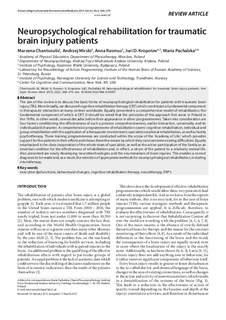| dc.contributor.author | Chantsoulis, Marzena | |
| dc.contributor.author | Mirski, Andrzej | |
| dc.contributor.author | Rasmus, Anna | |
| dc.contributor.author | Kropotov, Yury | |
| dc.contributor.author | Pachalska, Maria | |
| dc.date.accessioned | 2019-11-22T07:49:17Z | |
| dc.date.available | 2019-11-22T07:49:17Z | |
| dc.date.created | 2015-08-11T12:20:33Z | |
| dc.date.issued | 2015 | |
| dc.identifier.citation | AAEM: Annals of Agricultural and Environmental Medicine. 2015, 22 (2), 368-379. | nb_NO |
| dc.identifier.issn | 1232-1966 | |
| dc.identifier.uri | http://hdl.handle.net/11250/2629952 | |
| dc.description.abstract | The aim of this review is to discuss the basic forms of neuropsychological rehabilitation for patients with traumatic brain injury (TBI). More broadly, we discussed cognitive rehabilitation therapy (CRT) which constitutes a fundamental component in therapeutic interaction at many centres worldwide. Equally presented is a comprehensive model of rehabilitation, the fundamental component of which is CRT. It should be noted that the principles of this approach first arose in Poland in the 1970s, in other words, several decades before their appearance in other programmemes. Taken into consideration are four factors conditioning the effectiveness of such a process: comprehensiveness, earlier interaction, universality and its individualized character. A comprehensive programmeme of rehabilitation covers: cognitive rehabilitation, individual and group rehabilitation with the application of a therapeutic environment, specialist vocational rehabilitation, as well as family psychotherapy. These training programmemes are conducted within the scope of the ‘Academy of Life,’ which provides support for the patients in their efforts and shows them the means by which they can overcome existing difficulties. Equally emphasized is the close cooperation of the whole team of specialists, as well as the active participation of the family as an essential condition for the effectiveness of rehabilitation and, in effect, a return of the patient to a relatively normal life. Also presented are newly developing neurothechnologies and the neuromarkers of brain injuries. This enables a correct diagnosis to be made and, as a result, the selection of appropriate methods for neuropsychological rehabilitation, including neurotherapy. | nb_NO |
| dc.language.iso | eng | nb_NO |
| dc.publisher | Institute of Rural Health | nb_NO |
| dc.rights | Navngivelse-Ikkekommersiell 4.0 Internasjonal | * |
| dc.rights.uri | http://creativecommons.org/licenses/by-nc/4.0/deed.no | * |
| dc.title | Neuropsychological rehabilitation for traumatic brain injury patients | nb_NO |
| dc.type | Journal article | nb_NO |
| dc.type | Peer reviewed | nb_NO |
| dc.description.version | publishedVersion | nb_NO |
| dc.source.pagenumber | 368-379 | nb_NO |
| dc.source.volume | 22 | nb_NO |
| dc.source.journal | AAEM: Annals of Agricultural and Environmental Medicine | nb_NO |
| dc.source.issue | 2 | nb_NO |
| dc.identifier.doi | 10.5604/12321966.1152097 | |
| dc.identifier.cristin | 1257318 | |
| dc.description.localcode | Under the the Creative Commons Attribution-NonCommercial 3.0 Poland (also known as CC BY-NC) license. | nb_NO |
| cristin.unitcode | 194,67,40,0 | |
| cristin.unitname | Institutt for psykologi | |
| cristin.ispublished | true | |
| cristin.fulltext | original | |
| cristin.qualitycode | 1 | |

